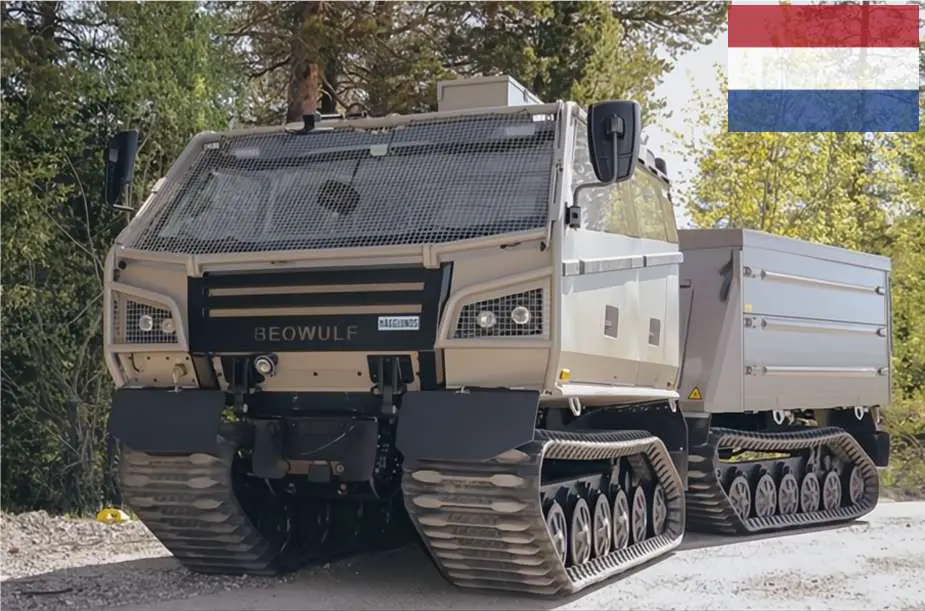The Netherlands Ministry of Defence (MoD) has announced its intention to proceed with the acquisition of new amphibious tracked All-Terrain Vehicles (ATVs) for the Dutch Marines, as part of the Future Littoral All-Terrain Mobility Band Vagn (FLATM BV) program. This decision comes after collaborative efforts with Sweden in a joint procurement initiative did not materialize, leading to delays in the FLATM BV program.
Follow Army Recognition on Google News at this link

The future amphibious ATV for the Dutch Marines could be the Swedish BvS10 Beowulf (Picture source: BAE Systems)
The Defence Project Overview 2023, published by the Netherlands MoD on September 19, revealed that discussions with Sweden concerning the purchase of these vehicles did not lead to cooperation. As a result, the D-phase of the FLATM BV program, which encompasses preparation for procurement and contract award, has been extended by a year, with the revised timeline now stretching from 2020 to 2027.
This delay affects the Netherlands' participation in the European Collaborative ATV (CATV) program, in which Sweden, the UK, and Germany are also involved. These countries are collectively acquiring 436 new BV410 ATVs from BAE Systems Hagglunds, with Germany expanding its order by an additional 227 vehicles earlier this year.
For the Netherlands, this setback in the completion of the D-phase is significant. The country initially planned to purchase 124 vehicles as part of the CATV project and initiated the A-Letter research phase for the FLATM BV program in 2021. However, the DPO 2022 report, released in September 2022, extended the D-phase to 2023 due to the failure to establish a partnership with the UK and Germany for an ATV platform.
In an effort to mitigate further delays, the Dutch MoD has opted to proceed with an ATV purchase from a single source. It has also left the door open for potential follow-on partners, with the UK and Germany being the first candidates if they choose to participate at a later date. The Netherlands cannot afford to wait for other countries focused on procuring an armored platform, as it requires an unarmored vehicle.
A shift in requirements for the FLATM BV program played a pivotal role in the dissolution of the partnership with the UK and Germany. The DPO 2022 report noted that operational needs have evolved, emphasizing the importance of a lighter unarmored variant suitable for fording deep water. This shift aligns with the Netherlands Marine Corps' desire for a platform that can be deployed amphibiously, withstand extreme weather conditions, and offer flexibility to meet the requirements of light amphibious infantry.
The Netherlands Marine Corps aims to replace a portion of its existing fleet, which includes 96 BV206 and 74 BvS10 Viking ATVs. While the initial requirement was for 124 vehicles, orders are expected to be at the higher end of the scale. The MoD is seeking a military off-the-shelf solution available in six different variants: logistics, mortar carrier, medical, recovery, command and control, and general transport.
The budget allocated for the FLATM BV program ranges from €100 million to €250 million ($263 million), making BAE Systems Hägglunds a likely contender given its production capabilities for both armored and unarmored ATVs. Sources suggest that the preferred single-source alternative is Beowulf, an unarmored version of the BvS10, which is also being purchased by the US Army under its Cold Weather ATV program, known as CATV.
In addition to the FLATM BV program, the Dutch Marines are also in search of a FLATM Patrol Vehicle (FLATM PV) platform to replace their BV206, Viking, and Land Rover vehicle fleets. This new platform will focus on all-terrain over-snow capabilities and include an ICT capability. The project timeline and delivery period for this initiative remain from 2025 to 2028, with an expanded budget ranging from €50 million to €250 million ($263 million). The A-letter research phase for this project has been extended through 2023.
The BvS10 Beowulf is an all-terrain tracked amphibious vehicle developed by BAE Systems Hägglunds. It was publicly unveiled at the DSEI 2015 and is considered a potential replacement for the older Bv 206, another tracked vehicle designed by Hägglunds for the Swedish Army. The base configuration of the BvS10 Beowulf serves as an unprotected platform that combines features from previous models, offering adaptability for potential future modifications. This vehicle is designed for strategic and tactical mobility, is suitable for a variety of global operations, and is capable of transportation over long distances via sea and air.
The BvS10 Beowulf displayed at DSEI 2015 was not armed, but it is believed that it can be equipped with weapon systems, such as a ring mount weapon station or a remote weapon station armed with 7.62mm or 12.7mm machine guns, if required for military purposes. The design of the vehicle consists of two units connected by an articulation mechanism, with the front unit featuring large windows and unarmored windshields. It has a weight of 8,000 kg, with a maximum gross vehicle weight of 15,000 kg. The front unit can carry up to 3 tons, while the rear unit has a capacity of up to 5 tons, suitable for personnel transport, cargo supplies, or humanitarian aid equipment. The BvS10 Beowulf offers flexibility through an easily exchangeable rear unit, enabling configuration adjustments for specific missions. It also provides space for the installation of interchangeable equipment using a C-rail system.
The BvS10 Beowulf shares its chassis and running gear with the BvS10. It is powered by a Cummins 6.7-liter inline 6-cylinder engine producing 285 hp, allowing a maximum speed of 70 km/h and a cruising range of 400 to 1,000 km. The Beowulf, with its full amphibious capability, can reach speeds of up to 4 km/h in the water, with rubber band tracks propelling it. It can handle gradients of up to 45% and cross trenches of up to 2 meters. The articulated steering and drive system enhances maneuverability, enabling it to navigate obstacles effectively. The suspension includes rubber-tired road wheels and track-return devices, ensuring stability.
















